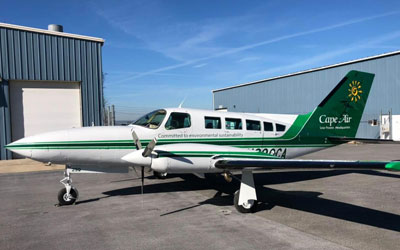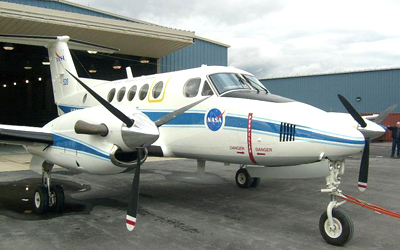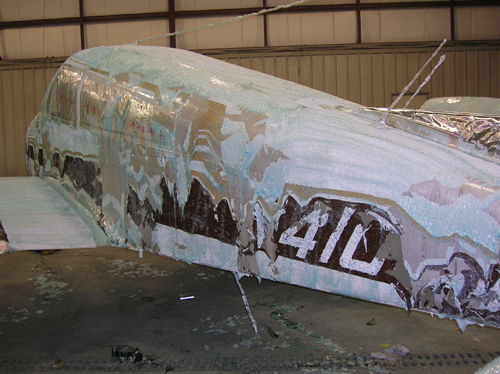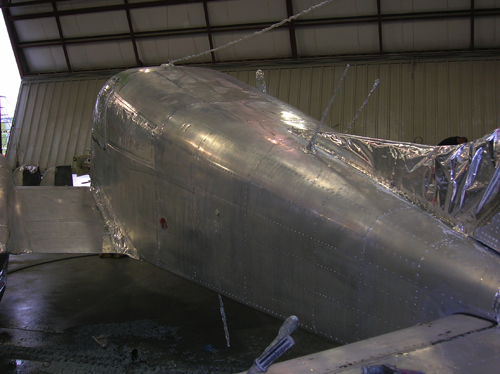
Custom Painting & Refinishing
Our clean and dedicated painting facility, combined with our professional and highly skilled staff, ensure an exceptional finish on your aircraft. Click here to view our photo gallery.


Painting Process
Royal performs the following process on each aircraft inducted for a full strip-and-paint:1. An A&P / I.A. will conduct an initial incoming inspection of the aircraft, looking for defects, dents, signs of corrosion, mechanical issues, leaks, etc. Particular attention is given to the windows, flight controls, skin surfaces and de-ice boots. Brakes and landing gear mechanisms are inspected for leaks. Engine cowlings are inspected for evidence of oil leaks and wings are inspected for evidence of fuel leaks. If discrepancies are found the owner will be notified and provided with photos, and a repair estimate will be prepared if requested.
2. Maintenance personnel will record travel limits, then remove the aircraft's ailerons, elevators, flaps and rudder. In the case of most helicopters, main rotor blades will normally be removed prior to painting.
3. All fiberglass / plastic / composite wing tips, landing light lenses, antennas, seams (on pressurized aircraft), static-ports, exposed hydraulic lines / hoses and other components that need to be protected from stripper are masked with aluminum barrier materials and tapes. All windows are masked with paper, followed by aluminum barrier material and tape. Wheels and gear-wells are masked with 4 mil plastic. Engines and all areas behind cowl openings are masked with plastic.
4. Aluminum surfaces are chemically stripped using an environmentally safe, peroxide-based aerospace stripper. Control surfaces and flaps are stripped separately. All stripper residue is removed, then the aluminum surfaces are power-washed with hot water and an alkaline water-based cleaner. A final hot water power-wash rinse is performed to remove any residue, then the surfaces are allowed to air-dry.


5. The aircraft will be unmasked completely and remasked for prep-work. Windows, static-ports, openings and all other areas not to be painted are masked with two layers of paper and masking tape.
6. An A&P / I.A. will perform a post-strip inspection on the aircraft and control surfaces, checking for any corrosion or other damage, or areas where old body-filler has been destroyed by the stripper. Photos are taken of any major defects and are forwarded to the owner. We require written or emailed approval from the owner before performing any additional work that will be billed as an additional item on a time and materials basis.
7. Areas of remaining paint on the aircraft that were protected from the stripper by aluminum barrier materials are hand-sanded to remove all remaining primer and paint. Landing gear-wells and painted portions of the landing gear mechanisms are hand-sanded. All plastic, fiberglass or composite items that will need to be painted are hand-sanded as well.
8. Mechanical and chemical means are used to clean-up any light corrosion found. All dust and sanding debris is rinsed off the aircraft, then the aircraft's aluminum surfaces are etched by hand-scrubbing them with an etching aluminum cleaner.
9. After the etching process is complete and the aircraft has been checked for a clean water-break, a chemical conversion-coating is applied to all exposed aluminum surfaces until a golden brown finish is achieved. This chemical serves the twofold purpose of acting as an adhesion promoter for the primer, as well as serving as a corrosion inhibitor. Magnesium surfaces are treated with an alternate conversion coating that will not burn the magnesium skins.
10. If any body-work is required and approved by the owner, it is performed using Duraglass, which is waterproof. Royal Aircraft Services does not use "Bondo" or any other automotive filler products, as they can absorb moisture which will promote corrosion of the underlying aluminum. (Note: Body-work generally cannot be performed on balanced control surfaces).
11. High-build primer is applied to all areas where body-work was performed and is hand-sanded smooth. High-build primer is also used on jets or other aircraft where a super-smooth finish is required or where it is desired to cover-up all traces of flush-rivets on the surface.
12. In the case of pressurized aircraft, all pressure-vessel seams are sealed using an OEM-approved seam sealant. When this is dry, high-build primer is sprayed over the sealed areas and hand-sanded smooth."
13. The aircraft, its control surfaces and any removed plastic, composite or fiberglass components are washed to remove any remaining traces of chemical or other contaminants, and allowed to air-dry. All remaining dust is removed using tack cloths, then corrosion-inhibiting aerospace primer is applied.
14. After the specified cure-time for the primer has passed, an aerospace base-coat is painted on the aircraft, its control surfaces and all removed components.
NOTE: Royal Aircraft Services will ONLY apply primers and coatings that are designed and manufactured expressly for aerospace applications. We do NOT apply automotive paints to aluminum aircraft. While many paint shops regularly use automotive painting products to save money, these products do NOT provide the same level of corrosion or UV protection as the more expensive aerospace paints that are designed and approved for these applications.
15. The design scheme, stripes and corporate / agency logos are laid out for painting on the aircraft. If the design scheme runs through the rudder or any of the control surfaces or other removed components, then these items are temporarily reinstalled to layout the stripe and logo designs, and removed for painting. Stripe, logo and design areas are hand-sanded, then the rest of the aircraft is masked from overspray and the design colors are painted on.
16. If included in the paint-quote, a final all-over clear coat is applied to enhance the finish and provide added UV and chemical protection for the new paint.
17. Maintenance personnel balance-check all control surfaces in accordance with the aircraft manufacturer's maintenance manual prior to final installation.
18. Flaps, control surfaces and all other removed components are installed in accordance with the aircraft manufacturer's maintenance manual. Any corroded, unserviceable or incorrect hardware that was found during removal of these items will be replaced with new hardware, after consultation with the aircraft owner. If included in the paint-quote, standard non-structural screws and CAMLOC fasteners will be replaced with stainless components during reassembly.
19. PR1425 B1/2 or other OEM-approved equivalent window sealant is applied around all windows prior to the aircraft receiving its final detailing. If the aircraft has inflatable de-ice boots, these will be cleaned and new edge-dressing will be applied. If included in the paint-quote, leading-edge bright work and spinners will be polished.
20. Our maintenance department will inspect wheels and ops-check the control surfaces, flaps, landing lights, etc. prior to performing the final inspection of the aircraft and preparing all required 337's and logbook entries for return-to-service. If requested and included in the paint-quote, gear-retraction tests and aircraft-weighing will be performed prior to the final inspection.


